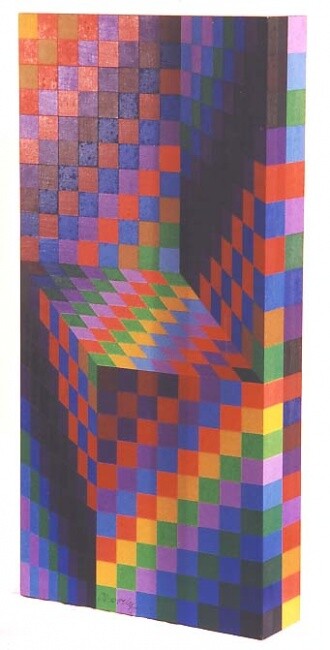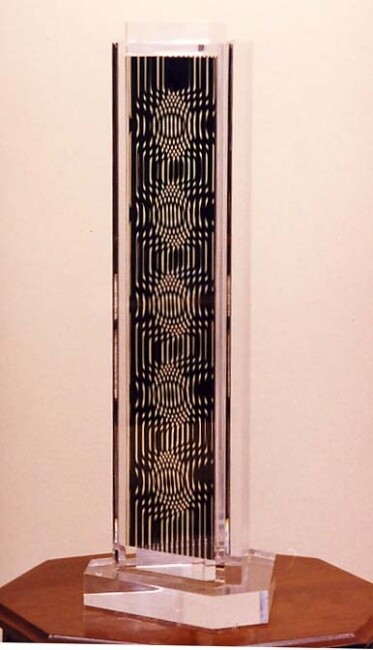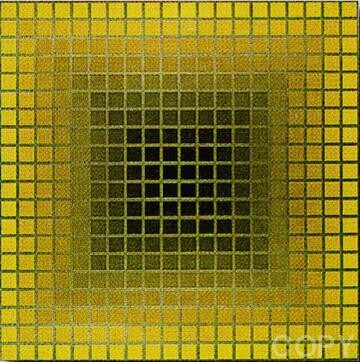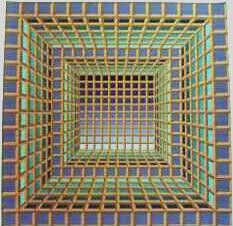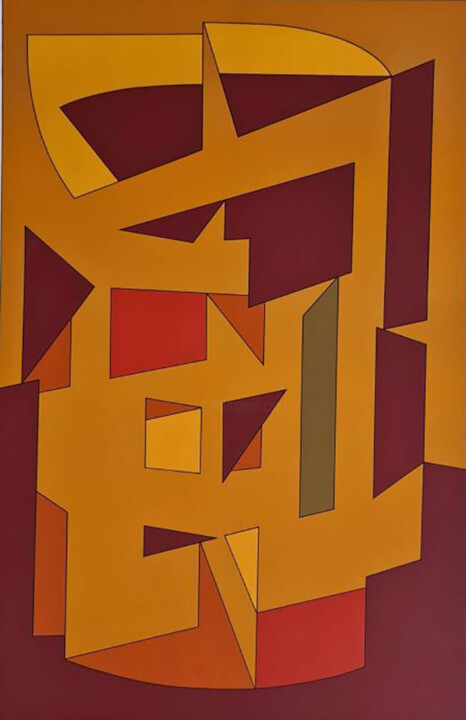Victor Vasarely, born Győző Vásárhelyi on April 9, 1906, and known for his significant contributions to the Op art movement, was a Hungarian-French artist celebrated for his pioneering use of optical illusions in art. Often hailed as the "grandfather" and leader of Op art, Vasarely's innovative approach to visual perception and geometric abstraction set the foundation for this unique art style. One of his most notable works, Zebra, created in 1937, is considered an early example of Op art, showcasing his mastery in creating visually dynamic and engaging compositions. Vasarely's legacy continues to influence and inspire the world of contemporary art, making him a pivotal figure in the history of modern art.
Artist Biography: Victor Vasarely
Victor Vasarely, originally named Győző Vásárhelyi, was born on April 9, 1906, in Pécs, Hungary. He is heralded as a seminal figure in modern art and is widely regarded as the father of the Op Art movement. Vasarely's journey into the art world began with an unconventional path; initially, he pursued medical studies at Budapest University in 1925. However, his passion for art soon overtook his medical ambitions, leading him to abandon his studies and enroll at the Műhely, a prominent art school in Budapest. The Műhely, which operated under the influence of Bauhaus principles, was a vibrant hub for avant-garde art and design. Here, Vasarely studied under the tutelage of Sándor Bortnyik, an influential figure who played a crucial role in shaping his early artistic vision. During his time at the Műhely, Vasarely was exposed to the concepts of geometric abstraction and the potential of optical illusions in art. This formative period laid the groundwork for his future explorations in visual perception. In 1930, Vasarely made a significant move to Paris, a city that was then the epicenter of the art world. In Paris, he continued to refine his artistic style, adopting the name "Vasarely," a phonetic adaptation of his Hungarian surname, Vásárhelyi. The Parisian art scene provided Vasarely with ample opportunities to experiment with abstract geometric shapes and to develop his unique visual language. The 1950s marked a pivotal era in Vasarely's career as he began to produce the works that would define his legacy. He developed a distinctive style characterized by meticulous arrangements of geometric forms and the use of contrasting colors to create optical effects. His works from this period, such as "Zebra" and "Vega-Nor," are considered masterpieces of the Op Art genre. The term "Op Art," short for Optical Art, refers to a style that uses optical illusions to engage and challenge the viewer's perception. Vasarely's contributions to this movement were groundbreaking, and he quickly gained international recognition for his innovative approach.
Beyond his contributions to fine art, Vasarely was deeply committed to the idea of "democratic art." He believed that art should be accessible to all, not just the elite. To this end, he produced multiples of his works, including serigraphs and lithographs, making his art more affordable and widely available. This approach not only broadened his audience but also made a significant impact on the commercialization of art. Vasarely's geometric and optical designs found applications in various commercial and industrial contexts, from graphic design and product packaging to architectural projects. Vasarely's work was celebrated in numerous exhibitions around the world, and he received many accolades throughout his career. One of his significant projects was the establishment of the Vasarely Foundation in Aix-en-Provence, inaugurated in 1976, which aimed to preserve his legacy and promote the study of kinetic and optical art. Additionally, Vasarely's influence extended into education and public art, as seen in his large-scale installations and collaborations with architects. Victor Vasarely's legacy is profound, influencing not only the field of Op Art but also inspiring future generations of artists interested in exploring the boundaries of visual perception and abstraction. He passed away on March 15, 1997, in Paris, leaving behind a rich body of work that continues to captivate and inspire. His innovative use of geometric forms and optical illusions remains a significant chapter in the history of modern art, cementing his status as a pioneering figure whose work transcends time and continues to resonate in the contemporary art landscape.
Brief History on OP Art
Op Art, or "optical art," is a unique visual art style that utilizes optical illusions to create dynamic and interactive experiences. Characterized by abstract patterns, often in black and white, Op Art gives the viewer impressions of movement, hidden images, and visual vibrations. The movement has roots in various art forms, including Neo-Impressionism, Cubism, Futurism, Constructivism, and Dada, with early influences from the Divisionists, who explored optical illusions and the effects of light. The term "Op Art" gained popularity after Time magazine highlighted Julian Stanczak's Optical Paintings in 1964, but artworks like Victor Vasarely's Zebras (1938) already showcased the movement's defining characteristics. Vasarely, often called the "grandfather" of Op Art, was crucial in its development, using geometric shapes and contrasting colors to manipulate visual perception. His works, such as Vega-Nor and Tlinko, exemplify the movement's exploration of depth and motion, while his plastic alphabet series became a hallmark of Op Art. The 1955 "Mouvements" exhibition in Paris, featuring Vasarely's work and the "Yellow Manifesto," introduced kinetic and optical art concepts to a wider audience. The 1965 exhibition "The Responsive Eye" at the Museum of Modern Art in New York City further propelled Op Art into the public eye, showcasing artists like Vasarely, Bridget Riley, and Richard Anuszkiewicz. The exhibition was a public success, despite mixed critical reception, and helped solidify Op Art's place in visual culture. Op Art's influence extended into graphic design, fashion, and advertising, reflecting the era's fascination with new technologies. Vasarely's advocacy for art's democratization, promoting the use of multiples and industrial techniques, culminated in the establishment of the Vasarely Foundation in Aix-en-Provence, dedicated to preserving and promoting his work and the Op Art movement.
Kallion (1989) by Victor Vasarely
Victor Vasarely, Kallion, 1989. Printmaking, Screenprinting on Paper, 264.2 cm x 185.4 cm.
Kallion (1989) is a limited edition printmaking artwork by Victor Vasarely. This piece, numbered 89 out of 250, showcases Vasarely's mastery in using geometric forms and vibrant colors. The artwork features a complex interplay of straight lines, curves, and repetitive motifs that overlap, creating a dynamic and visually captivating composition. Dominated by warm browns and oranges, Kallion engages the viewer with its rich color palette and intricate design. Vasarely employed the screenprinting technique for this piece, a process that involves transferring ink through a finely meshed screen to imprint patterns onto paper. This method enabled Vasarely to meticulously reproduce his patterns and explore the interplay of colors and textures. Kallion is a striking example of Vasarely's signature style, where he deftly manipulates effects to evoke illusions of movement and depth. The artwork's vibrant arrangements exemplify the artist's ability to transform static images into seemingly kinetic experiences, challenging the viewer's perception. Kallion not only reflects Vasarely's artistic prowess but also his significant influence on the Op Art and kinetic art movements.
Mexico City by Victor Vasarely
Victor Vasarely, Mexico City. Printmaking, 66 cm x 66 cm.
Mexico City is an original limited edition serigraph by Victor Vasarely. This printmaking piece, pencil-signed by the artist, measures 26"x26" unframed. The artwork prominently features a vibrant yellow color palette, with black lines intricately adding depth and dimension to the composition. The yellow tones create a gradient effect, fading towards the borders of the canvas and converging at a central focal point, which appears as a spherical form. The artwork is characterized by a grid pattern, a hallmark of Vasarely's style, which adds a structured, yet dynamic element to the piece. Mexico City showcases influences from various art movements, including Impressionism, Cubism, Futurism, and Dada, blending these styles into a composition that borders on the abstract. The interplay of geometric forms and color gradients in this serigraph not only demonstrates Vasarely's mastery of optical illusions but also his exploration of the boundaries of visual perception.
Iconic Artworks
Sophia (1954) exemplifies Vasarely's transition from figurative to geometric abstraction, with a grid of black lines on a white background creating illusions of movement and three-dimensionality. This work reflects Vasarely's exploration of abstraction influenced by Constructivism and his fascination with visual perception. Vega III (1957-59) is a key piece showcasing the distinctive chequerboard pattern distorted to produce concave and convex illusions, marking a significant development in his style and a critical moment in the history of Op Art. Alphabet VR (1960) represents Vasarely's revolutionary "Alphabet Plastique," a system of forms designed for infinite compositional possibilities, reflecting his desire for a universally accessible visual language. Vega-Nor (1969) features a spherical form composed of distorted squares, demonstrating Vasarely's use of vibrant colors and his ongoing quest to represent depth and motion. Ambigu-B (1970), from the "Homage to the Hexagon" series, combines color variations and shapes to create dynamic optical illusions, bridging the gap between macrocosm and microcosm. Lastly, Kettes (1984), a sculptural piece adorned with hexagonal patterns, illustrates Vasarely's application of color theory to three-dimensional forms, reflecting his interest in both spiritual and scientific dimensions.
Victor Vasarely received several prestigious awards, including the Guggenheim Prize in 1964, the French Chevalier de L'Ordre de la Légion d'honneur in 1970, the Art Critics Prize in Brussels, and a Gold Medal at the Milan Triennial. His legacy is celebrated in various museums dedicated to his work, including the Fondation Vasarely in Aix-en-Provence, France, established in 1976, and the Vasarely Museums in Pécs, Hungary (1976), and Zichy Palace, Óbuda, Budapest, Hungary (1987). The Vasarely Museum in the Saint-Firmin Palace in Gordes, France, operated from 1970 until its closure in 1996. His legacy continues to resonate in the art world, with his influence extending across multiple generations and mediums. In 2012, the Musée en Herbe in Paris showcased a new Vasarely exhibit, highlighting his lasting impact on contemporary art. His work even made its way into popular culture, gracing the original UK cover of David Bowie's 1969 album, "David Bowie." The Centre Georges Pompidou honored Vasarely in 2019 with the exhibition "Le Partage des Formes," further cementing his role as a pivotal figure in the Op Art movement. Most recently, in July 2024, a permanent exhibition of his works from the Arkas Collection was inaugurated at the Arkas Art Center in Alaçatı, featuring the participation of his son, Jean-Pierre Yvaral. This enduring presence in major exhibitions and collections underscores Vasarely's profound and ongoing influence on both the art community and broader cultural landscape.




 Selena Mattei
Selena Mattei


